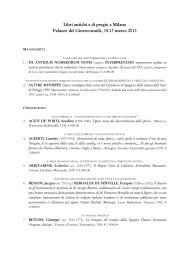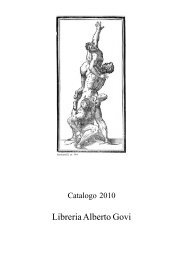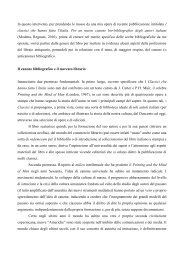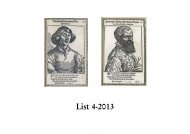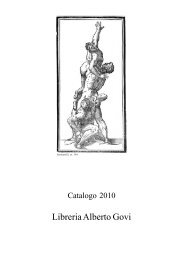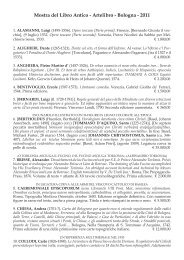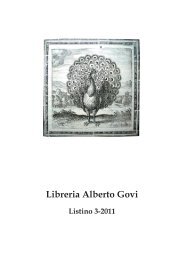and a desire to preserve their memory for posterity. Thework is also interesting for the numerous names of Arabicastrologers appearing in it and for legal literature (cf. P.Zambelli, Da Aristotele a Abu Ma’shar, da Richard de Fournivala Guglielmo da Pastrengo, un opera controversa di <strong>Alberto</strong>Magno, in: “Physis”, XV/4, 1973, pp. 375-400). The authorobtained many of his informations directly from manuscriptsin the famous library of the Capitolo of Verona.Guglielmo was born in the little village of Pastrengo,between Verona and the Garda Lake. He studiedjurisprudence under Oldrado da Lodi and acquired thepost of notary and judge, which he filled at Verona. In 1335he was dispatched by Mastino della Scala, lord of Verona,to Pope Benedict XII at Avignon. On this embassy hebecame acquainted with Petrarch (cf. A. Foresti, Aneddotidella vita di Francesco Petrarca, Padova, 1977, pp. 158-166).A lifelong friendship between the two humanists arose. Inone of Petrarch’s verse epistles there is a charming glimpseof the manner in which two such scholars, more than sixhundred years ago, could divert themselves. After Petrarchhad been crowned poet laureate at Rome in 1341, he residedfor about a year at Parma and wrote to Guglielmo, butthey do not appear to have met. In 1345, however, Petrarchsaw Guglielmo at Verona, and one of the letters describeshow Petrarch on his return to Avignon was accompaniedby Guglielmo to the Veronese frontier, and the sorrow withwhich they parted. From their letters, indeed, it is plainthat they were on the most affectionate terms with eachother, and as a further proof of it Petrarch sent his son in1352 to Guglielmo to be educated (cf. A. Avena, Guglielmoda Pastrengo e gli inizi dell’umanesimo in Verona, in: “Atti ememorie dell’Accademia d’agricoltura, scienze, lettere, arti e commercio di Verona”, s. 4/VII, 1907, pp. 229-299;and L. Castellazzi, Guglielmo da Pastrengo e la sua famiglia, in: “Pastrengo. Miscellanea di scritti”, P. Brugnoli, ed.,Verona, 1969, pp. 129-140).The editor, Michelangelo Biondo (1500-after 1565), was born in Venice and studied humanities and medicinewith Agostino Nifo at Naples, where he also practised as a physician. From 1535 to 1545 he lived principallyat Rome (with a short stay at Venice in 1542). Here he won the protection of Pope Paul III and published numerousmedical works, among them a treatise on paediatrics and on syphilis; participated in the dispute over critical daysbetween Fracastoro and the papal physician Andrea Turino, showing that he still adhered to Arabic astrology. In1545 he definitively settled at Venice and became the editor of his own and other author’s works. Although he callshimself ‘bookseller and printer’ and his books usually bear the address ‘Ex tugurio Blondi sub Apolline’, he had infact printed them by Venetian printers as the Sabbio brothers, Comin da Trino, Bascarini, etc. (cf. G. Innamorati, Extugurio Blondi, in: “Paragone. Letteratura”, XXXVI/428, 1985, pp. 10-37). On the last leaf is a list of titles Biondo haspublished or is about to publish all protected by a privilege by the Venetian Senate. Among his non-medical writingsof that period is an important work on painting and art theory Della nobilissima pittura et della sua arte (1549).Adams, P-412; Edit 16, CNCE22292; Guglielmo da Pastrengo, De viribus illustribus et de originibus, G. Bottari, ed.,Padova, 1991, pp. XCVII-XCVIII/E; Repertorium fontium historiae Medii Aevi, (Roma, 1989), V, p. 314; A. Romano,Michelangelo Biondo poligrafo e stampatore, in: “Officine del nuovo. Sodalizi fra letterati, artisti ed editori nella culturaitaliana fra Riforma e Controriforma”, H. Hendrix & P. Procaccioli, eds., (Roma, 2008), p. 240; M.B. Stillwell, TheAwakening Interest in Science during the First Century of Printing, (New York, 1970), p. 280, no. 868a. € 1.800,0016 th century love poetry22) PARABOSCO, Girolamo (ca. 1524-1557). Rime. Venezia, Gabriel Giolito de’ Ferrari, 1547.12mo; later vellum over boards, manuscript title on spine; 65, (5), (2 blank) ll. Printer’s device on the title-page andat the end. Title-page a bit soiled, some light foxing, but a very good, genuine copy.PARTLY ORIGINAL EDITION. Parabosco published the first part of his verses in 1546 with a dedication to Eleonorade’ Medici. The following year he reissued a selection of those poems, adding some new compositions, anddecided to have them published with a new dedication to Anna d’Este.“Nel 1546 aveva il Parabosco pubblicata la Prima parte delle rime in Venezia, presso Tommaso Botiettain 8vo, dirigendola ad Eleonora de’ Medici duchessa di Firenze. In questa nuova pubblicazione del 1547 l’autoreriprodusse una parte delle medesime composizioni, insieme con altre inedite e, considerandola come libro nuovo,la dedicò ad Anna da Este principessa di Ferrara, in lode della quale sono i primi sonetti che vi si leggono. Ma ilParabosco, come altri contemporanei, fu solito valersi delle cose proprie in più modi, e farne cucina con più salse.Le ottave in lode di Venezia, che sono stampate in questo libretto (p. 19), furono da lui ristampate l’anno 1548 nel- 26 -
Tempio della Fama; e così ne trasse trentadue ballate o madrigali (salvoerrore nel contarli), per aggiungerli con altri nel Primo libro de’madrigali stampato nel 1551; e forse si trovano nei suoi rarissimi equasi ignoti libri di Madrigali colla musica. La Seconda parte delle rime,dove stanno otto capitoli burleschi, uscì poi in luce nel 1555 a Venezia,presso Francesco e Pietro Rocca fratelli; ed in questa sono ripetuti tresonetti della edizione giolitina” (S. Bongi, Annali di Gabriel Giolito de’Ferrari, Roma, 1890, I, p. 147).Parabosco’s Rime contain mainly sonnets and canzoni onsuch love topics as the beloved’s beauty, jealousy, unrequited love,etc. But they also contain 5 pastoral letters (Selve) in blank verse anda dialogued Egloga which has as interlocutors Elicone and Bargeo (cf.F. Bussi, Umanità ed arte di Girolamo Parabosco. Madrigalista, organista epoligrafo, Piacenza, 1961, pp. 82-87).Little is known of Girolamo Parabosco’s early education, buthe had his first instruction from his father Vincenzo, who was an organistat the cathedral of Brescia. According to Zarlino (Sopplementimusicali, 1588, p. 326), in 1541 he became a pupil of Adrian Willaert(who was eulogized in his comedy La Notte). He made several tripsto Florence, Urbino, Ferrara, Piacenza, Brescia, Padua and Verona.Returning to Venice, he was appointed in 1551 first organist at St.Mark’s, retaining this post until his death. He was active in literaryand musical academies in Venice and knew Anton Francesco Doni,Andrea Calmo, Pietro Aretino and Titian. Parabosco was not only atalented dramatist (he published eight comedies between 1546 and1556), but also a skilled poet (Madrigali, 1546; Il Tempio della Fama,1548) and a writer of ‘novelle’ (I Diporti, ca. 1550). Almost all his musicproduction is now lost (cf. Bussi, op. cit., pp. 7-44).Edit 16, CNCE26060; G. Bianchini, Girolamo Parabosco, scrittore e organistadel secolo XVI, Venezia, 1899, p. 262. € 950,00printed by the Brucioli brothers23) CABASILAS, Nicolaus (d. 1369 ca.) - HERVET, Gentian ed. (1499-1584). De divino altaris sacrificio.Maximi, de mystagogia, hoc est, de introductione adSacra Ecclesiae mysteria, seu Sacramenta. Divi Chrysostomiet Divi Basilij sacrificij, seu missae ritus, ex Sacerdotaligraeco. Gentiano Herveto Aurelio Interprete. [itfollows:] Haereticarum fabularum compendium [libriIV]. Divinorum decretorum epitomes. Ad lectorem admonitio.Venezia, Alessandro Brucioli e fratelli, 1548.Two parts in one volume; 18 th century sprinkled paperover cardboard, red sprinkled edges, manuscript title onspine; (8), 142 [i.e. 134], (2) ll. + 149-255 [i.e. 239], (1) ll.Leaves Q6, S6 and ii8 are blank. Leaves 49-56 omitted inpagination. The last 2 pages (249v/250r) of the Divinorumdecretorum epitomes have been wrongly inverted. Printer’sdevice on the title-page. A nice copy.FIRST AND ONLY ITALIAN EDITION, printed by theBrucioli brothers, of this important work of the Byzantinetheologian Nicolaus Cabasilas which started the controversybetween Western and Eastern Church on the formof the Eucharist. The edition was supervised by the theologianGentian Hervet, who also signed the dedication tothe bishop of Mirepoix (Ariège), Claude de la Guiche.Internal references to the text in the Ad lectoremadmonitio (ll. 250v-255r) show unequivocally that the writingswhich form the second part were meant to followthe first tract. The Haereticarum fabularum compendium isan abstract from the edition of the Eranistes by Theodoretof Cyrus (393-457) published in Venice by Giovanni Farriin 1548. The printing material is the same in Farri’s andin Brucioli’s edition (cf. E. Barbieri, La tipografia dei fratelliBrucioli, l’attività editoriale di Antonio e il Cabasilas di Gent-- 27 -
- Page 1 and 2: Catalogue 2013Libreria Alberto Govi
- Page 3 and 4: Catalogue 2013Libreria Alberto Govi
- Page 5 and 6: an hitherto unknown philosophical m
- Page 7 and 8: ustica Lib. X., edited by Giorgio M
- Page 9 and 10: the end is furthermore printed the
- Page 11 and 12: without typographical data, but pro
- Page 13 and 14: Letteratura Italiana”, CXL, 1963,
- Page 15 and 16: as secondary only.The present two e
- Page 17 and 18: position as secretary at the court
- Page 19 and 20: From 1528 he was rector of the newl
- Page 21 and 22: famous personage was in high favor
- Page 23 and 24: Luigi Alamanni and Antonio Brucioli
- Page 25: In Pincio’s biography of Bernardo
- Page 29 and 30: power, and yet to make it possible
- Page 31 and 32: lini, Andrea Alciati, Lilio Gregori
- Page 33 and 34: phy in particular, was presented as
- Page 35 and 36: quale quello che lui auspicava, e l
- Page 37 and 38: After the flight of the Medici from
- Page 39 and 40: to learn from their own experience
- Page 41 and 42: with some manuscript compositions p
- Page 43 and 44: death sentence issued against him o
- Page 45 and 46: the key work to Della Casa’s thou
- Page 47 and 48: important ones along with those of
- Page 49 and 50: a heavily annotated copy44) HORATIU
- Page 51 and 52: solitudine (1545), but undoubtedly
- Page 53 and 54: provide less description of patholo
- Page 55 and 56: the most up-to-date scientific ency
- Page 57 and 58: (pp. 4-10) written by the author hi
- Page 59 and 60: successivi alla consapevolezza che
- Page 61 and 62: night [February 22]. Rarely does a
- Page 63 and 64: subjects, including Saint-Gelais’
- Page 65 and 66: Catherine de’ Medici, succeeded o
- Page 67 and 68: losofico ed allegorico delle Metamo
- Page 69 and 70: The act concerning primogeniture is
- Page 71 and 72: are not many in number but who are
- Page 73 and 74: the Camilletta, his first work, Gut
- Page 75 and 76: selig, sich nit allein zu kunst geg
- Page 77 and 78:
dle, or low. There are, however, pr
- Page 79 and 80:
nity: ‘mercenaries should be done
- Page 81 and 82:
colò Sfondrati), to whom the Causa
- Page 83 and 84:
close of Semiramis’ career. Ninus
- Page 85 and 86:
e contenuti matematici in Henri de
- Page 87 and 88:
The first Hungarian dictionary - Cr
- Page 89 and 90:
& T. Kovács, Deutschlernen in den
- Page 91 and 92:
chitectura’ des Wenzel Dietterlin
- Page 93 and 94:
neo-Latin anthology devoted exclusi
- Page 95 and 96:
as De la puissance ecclésiastique
- Page 97 and 98:
colazione was not eaten first thing
- Page 99 and 100:
advanced both the technical and the
- Page 101 and 102:
di Giorgio Zorzi, ambasciatore in O
- Page 103 and 104:
the Misnah100) MISNAYOT MESUDAR NAS
- Page 105 and 106:
the task of taking part to the nego
- Page 107 and 108:
This is the only iconological work
- Page 109 and 110:
on that occasion, were described an
- Page 111 and 112:
millo Camilliani, Francesco’s son
- Page 113 and 114:
Blanchard, Correggio and Mignard, R
- Page 115 and 116:
di Cicerone d’ottime antiche stam
- Page 117 and 118:
Pietro Aretino125) MAZZUCHELLI, Gio
- Page 119 and 120:
music129) TESTORI, Carlo Giovanni (
- Page 121 and 122:
Vol. VIII (1773): pp. (6), 854 with
- Page 123 and 124:
Di Felice e Gregorio Fontana, 1905,
- Page 125 and 126:
Cicognara, no. 190 (“Nelle quattr
- Page 127 and 128:
mo: fonti, theorie, modelli, 1750-1
- Page 129 and 130:
commentary on the treaty on shabbat
- Page 131 and 132:
poet laureate of Austria, and he le
- Page 133 and 134:
geo-political situation of the regi
- Page 135 and 136:
ope collecting views and pictures o
- Page 137 and 138:
inc.), 100 numbered engraved plates
- Page 139 and 140:
a gift from Emperor Napoléon III t
- Page 141 and 142:
Ardène, no. 123Caprara, no. 103 Tr
- Page 143 and 144:
Speckle, no. 73 Besson, no. 60- 143



